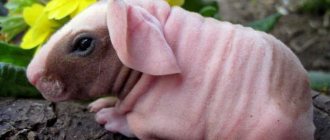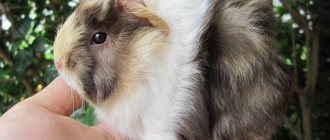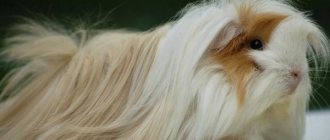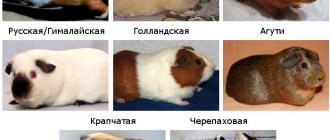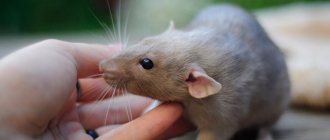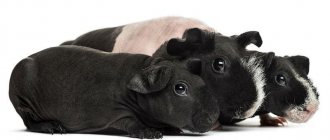What does Skinny pig look like?
Skinny the guinea pig has a rather unusual appearance:
- stocky body with subtle folds, covered with barely noticeable fluff;
- absence of hair or partial presence of it on the head, neck and paws;
- short legs with developed toes;
- large head and short neck;
- large drooping ears;
- round eyes of chocolate, black or red;
The hairless pig's color ranges from light to dark shades: white and cream, purple, brown or black. Color is expressed in one color or several.
The size of an adult does not exceed 30-35 cm in length and weight - 1 kg, with females being smaller than males.
Breeding history
First of all, it is worth saying that these breeds today are distinguished by their high cost. This is due to the fact that there are quite a few nurseries that specialize in their breeding, and the price is also affected by difficulties in finding individuals of this breed.
It is also worth mentioning that the Skinny and the Baldwin are two different breeds, the similarity of which lies in the absence of hair, in other words, they are hairless. It just so happened that these two breeds are not separated and all hairless animals are called skinnies. In the photo we can see that Baldwins have no hairs completely, while Skinnies have them on their paws and nose.
Canadian scientists have been breeding for many years; a huge amount of research and experiments have been carried out until they managed to create such an amazing breed, which is experimental. In 1976, we also learned about these cute hairless animals, but American breeders to this day do not recognize rodents as a separate nosological group.
At the initial stage of development, individuals of this breed were albinos, and also had red gasps. But after some time, we managed to get a variety of colors of the animals, black, brown and even pink, and the color of the eyes also changed.
Breeders are still working on breeding today and are not going to stop their work, because they want to get livestock that would have a good gene pool. After all, as we all know, skinnies are not the owners of good health, and all for the reason that frequent inbreeding was allowed.
Regarding the name Skinny, it is not entirely clear where it came from, because if we look at the literal translation, it means “bones covered with skin,” but these plump little animals cannot be called skinny, this can be seen in the pictures.
Regarding the “hairless” gene, it is recessive, which means that when crossing a hairless pig and a long-haired one, the offspring will be “woolly”. But, the offspring of such a crossing will have a “bald” gene, therefore, under certain conditions, it can produce naked children.
Another variety of bald animals is the Baldwin; this population is much younger, no more than 20 years old. It appeared due to a natural mutation, but breeders decided to fix it.
Character and behavior of Skinny guinea pigs
Owners of Skinny pigs note their intelligence, friendliness and loyalty. They are not only not aggressive, but also extremely affectionate towards their owners, their own kind and other pets. You won't have to choose between pets - the pig will get along with everyone.
If a pet is purchased for a child, then the age of the child should be taken into account. Skinny pigs are friendly, but do not tolerate mistreatment.
Important! The child must understand the difference between a toy and a living creature - if you constantly fiddle with the pig and grab it carelessly, it will die.
It will take about two weeks to tame the animal. During this time, he will get used to the owner and will not shy away from his hands. Moreover, having felt a good attitude, the pig will ask for attention and care, and will greet the owner with joyful whistling and rumbling. And if it is not possible to constantly spend time with the animal, and there are no other animals in the house, then it is better to have two or three animals.
Skinnies are smart, have a good memory and are trainable. With regular training, the pet will learn to respond to its name, stand on its hind legs, play ball and perform simple tricks.
Guinea pigs are sensitive and cannot tolerate not only rudeness and violence, but also loud sounds and sudden movements. In addition, they are careful with strangers, so it is better not to give the animal into the hands of someone it sees for the first time, so as not to scare it.
Invisible dangers
When you look at the skinny, it seems strong. But this animal is gentle and vulnerable.
If a pig falls from even a small height, its internal organs may be damaged. Often suffers from intestinal rupture.
Since the weight is decent, there is a lot of load on the paws. With improper nutrition, lack of phosphorus and calcium in the body, paws can become bent.
Hypothermia is dangerous. It is not recommended to take your pig outside during the cold season. Sometimes caring owners sew clothes for their pet. But it saves only partly.
How long do hairless Skinny guinea pigs live?
The first individuals of the Skinny breed were born with weak immunity and did not adapt well to the environment. Breeders solved this problem by crossing animals with selfies and succeeded in doing so.
The lifespan of animals has increased to 5-8 years. But, of course, for each individual everything is individual and depends on the conditions of detention and heredity.
Important! Skinny guinea pigs live only at home.
It is better to keep skinny in a terrarium
Breeding
To get offspring from a skinny, you need to get a mate for your animal. Organize comfortable living conditions and nutritious meals. Breeding skinny pigs is a simple task.
At 6–8 months, the female is ready to continue the race. Males become sexually mature starting at three months. However, the optimal age for producing offspring is six months for females and 7 months for males.
Pregnancy lasts about 70 days. Throughout this period, the female must be carefully protected from stress and well fed.
Care and maintenance at home
Caring for Skinny is almost the same as for furry representatives of the species, but there are some nuances associated with their unusual appearance and body characteristics.
Home equipment
It is better to keep the Skinny animal not in a cage, but in a terrarium or dune cage, where it will be comfortable and will avoid drafts and temperature changes. Place the home away from direct sunlight, but in a well-lit place, on a table or bedside table. This is important for a pig, since hairless skin is very sensitive to ultraviolet radiation. The temperature in the room should not be lower than 22 degrees.
In the cage or terrarium the following is additionally installed:
- cozy house;
- heating lamp;
- be sure to have a silent sippy cup - pigs are afraid of unexpected sounds;
- ceramic bowl - it is heavier and difficult to turn over;
- soft mink bag for extra comfort.
A layer of wood filler is poured onto the bottom of the cage, which will absorb moisture, sawdust is placed on top of it, and hay is placed on top, partially or all over the floor.
Important! The straw must be soft and of high quality so that the pig does not get injured on the hard grass.
Feeding
Skinny pigs love to eat and drink - this is how they maintain normal body temperature. Poor nutrition will lead to obesity and disease, so the diet requires balance.
The main food of the animal is:
- fresh greens - lettuce, dandelion and plantain, clover, dill and parsley, spinach and celery, alfalfa, chamomile and yarrow;
- grain - oats, rye, wheat, corn;
- vegetables - cucumbers, carrots, eggplants, pumpkin, cabbage (a little), sweet peppers;
- fruits - apples, pears, dried rose hips;
- fresh soft hay.
It is difficult for Skinny Pig to control his healthy appetite, so the owner must organize his meals. You need to feed the animal 2-3 times a day, but the smaller the number of feedings, the more food you need to put in the bowl. At one time, a couple of tablespoons of food is enough for the animal, but this is with three meals a day.
In addition, the cage should always have clean water and hay for the baby to snack on between meals.
Important! You should not pamper your pet with foods high in sugar and starch.
Reference! Vitamin C should be added to Skinny pig's food or water.
There is nothing complicated about skinny skin care
Rodent body care
The biological characteristics of the Skinny pig also determine the rules for caring for them. The body of a pet that is devoid of hair raises especially many questions.
Bathing and skin care
There is nothing difficult about caring for a pet.
- The animal’s skin does not need to be lubricated with creams and oils - the subcutaneous glands produce natural lubrication and protection, which is important not to disturb by frequent bathing.
- You should wash your pig only when absolutely necessary and without using shampoos with fragrances. It’s better to wipe your pet with a damp cloth.
- It is better not to use wet wipes - they are saturated with chemical compounds.
Have you tried washing your guinea pig?
Care of claws, teeth, ears
Skinny pig's sharp claws need to be trimmed periodically, as they grow quickly and curl, which deforms the fingers, makes it difficult and causes pain when walking. It is better to trim claws with special nail clippers for small animals.
The animal's teeth are ground down and cleaned naturally, thanks to solid food - grain, hay, apples, cucumbers and crackers. In addition, wooden logs made of birch, aspen, rowan, apple or pear can be placed in the cage. The pig will chew them with pleasure and grind his teeth at the same time.
Skinny the pig's ears are wiped with a dry cloth every few weeks. Bad smell from the ears indicates ear parasites - in this case, the animal is taken to the veterinarian.
Cleaning the cage
The cleanliness of an animal depends on its character and, to some extent, on the patience of the owner - some individuals are clean and even accustomed to the tray, but this cannot be expected from everyone.
The animal relieves itself most often in the corners, which must be cleaned as they become dirty. Once a week you need to completely change the filler and sawdust - then you can avoid the smell.
Over time, the drinking bowl becomes clogged and algae forms in it. In this case, the device is cleaned with a bottle brush.
Diseases and breed defects
Skinny pigs have a large oval-shaped head, a large rounded nose, widely spaced ears, slightly tilted forward. The animals have a wide, flat back, a short neck, a developed chest and small paws. Violation of basic characteristics is considered a deviation from the norm.
Common Skinny breed defects include:
- narrow chest and shoulder blades;
- the presence of humps on the back and deflections;
- curvature and looseness of the paws.
The most common diseases of Skinny pigs are:
- parasite damage;
- injuries due to improper care;
- rickets due to lack of vitamins and sunlight;
- colds from hypothermia;
- indigestion;
- eye diseases due to infections and injuries;
- obesity.
Nutrition
Skinny's food list should include high-quality hay, grains, vegetables, fruits, roots, lush greens and pellets.
Feeding rules:
- The animal should always have hay lying around. It helps grind teeth. Musty, stale hay should absolutely not be given to animals. Grain hay is recommended rather than legume hay.
- Grain or other dry food is poured into the feeder no more than 2 tablespoons per day. Ready-made herbal pellets should also be present in the diet.
- Juicy food is added as it is eaten. These are carrots, apples, lettuce, pumpkin. Sweet bell peppers are very useful for replenishing vitamin C.
- The drinking bowl should always be filled with water. The animal drinks approximately 250 grams of liquid per day. For females who bear offspring, the norm is increased.
- Treats for skinny are cookies (low-fat dry), crackers, nuts, natural dried fruits without additives.
- Potatoes, eggplants, avocados, garlic, radishes, radishes and mushrooms do not need to be given to the pig.
To make your pet feel full, you can sometimes additionally cook liquid porridge from tasty cereals in water.
To support immunity, vitamins can be added to the water. This water is poured with the expectation that the animal will drink it immediately. Sometimes they practice feeding vitamins to the pig from a syringe.
How to choose a Skinny guinea pig and how much does it cost?
The cost of a Skinny guinea pig depends on its breed characteristics - color, age and genetic characteristics. They are valued quite highly - from 4 to 9 thousand rubles.
The most popular are those in gold-cream, gold, chocolate-cream, tortoiseshell, and agouti colors. In nurseries, the price is much higher than in private animals, which can be purchased at several times cheaper. But it is better to take animals from trusted places, so as not to purchase a known sick pig.
Skinny guinea pig – video
Skinny Pig is a touching and funny animal that can replace both a cat and a dog. He easily adapts to the owner’s lifestyle, shares business and leisure time with him, rejoices at him and gives him many positive emotions. And caring for him is no more difficult than other pets.
